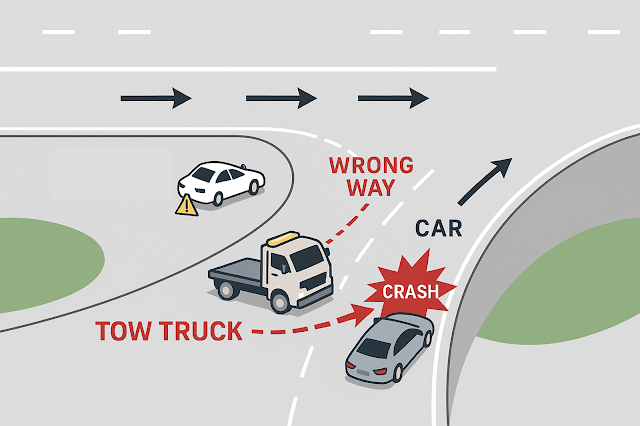Pre-Crash Circumstances
Road Layout
Interstate 35 is a six-lane highway (3 lanes per direction), with separate on-ramps for each side.
The on-ramp in question is a curved, single-lane structure about 280 meters long.
Guardrails on both sides leave minimal shoulder or escape space.
Due to the ramp's sharp curve, visibility is severely limited at the midpoint.
Traffic Flow
The incident occurred during early morning rush hour.
At the time, vehicle volume was moderate (approx. 6–10 vehicles per 5 minutes).
The Nissan Altima was entering the ramp as part of normal flow; the tow truck entered from the bottom end, traveling in the wrong direction.
The Altima was driving normally and legally up the curved on-ramp to access I-35.
A broken-down vehicle (Hyundai Elantra) had been stopped on the adjacent shoulder.
A tow truck, unable to access from the proper direction, decided to drive approximately 250 meters up the ramp in reverse direction to reach the vehicle.
Crash Description
Tow Truck Maneuver
Entered the on-ramp without U-turn or police coordination.
No emergency lights, flares, or signage were used—only hazard lights.
Collision
The Altima entered the curve at 55–60 km/h; the tow truck was traveling at ~40 km/h in the opposite direction.
A head-on collision occurred roughly 30 meters past the curve, in a blind zone.
The Altima sustained severe front-end damage; the driver suffered bilateral leg fractures and cervical injury.
CCTV Evidence
Footage showed the tow truck traveling the wrong way for 9 seconds.
No signage, cones, or flashing beacons were deployed to warn approaching traffic.
Legal Issues & Judgment
1. Emergency Intent vs. Traffic Law Compliance
The tow truck operator claimed the wrong-way entry was justified for roadside assistance.
The court ruled that private tow trucks are not emergency vehicles, and therefore must fully comply with traffic laws.
Wrong-way driving on a highway ramp was deemed an egregious violation.
2. Avoidability & Visibility
Defense argued the Altima driver could have braked or swerved.
The court, using visibility and reaction-time analysis, found no realistic chance of avoidance due to the curve and short distance to impact.
3. Insurance Dispute
The Altima’s insurer paid the claim and pursued subrogation.
The tow truck’s insurer argued for partial fault due to misjudgment but was overruled.
The court classified the tow truck’s actions as gross negligence.
Final Ruling
Civil Damages : Over $100,000($43,000 medical costs, $20,000 for pain & suffering, 12,000 vehicle total loss, $15,000 projected impairment, $10,000 legal fees)
Criminal Penalty : Guilty of reckless driving
Fault Allocation : 100% Tow Truck Driver’s Fault
